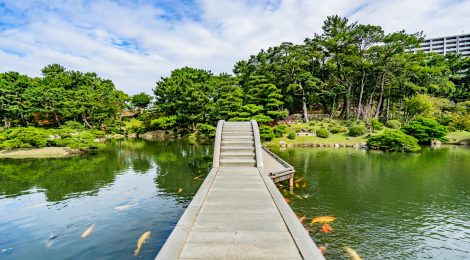
Shukkeien Garden
A lake garden in Hiroshima with a memorial for the victims of the atomic bomb
Hiroshima, a city known for its tragic history as the first city to suffer a nuclear attack during World War II, is also home to a beautiful and serene lake garden called Shukkeien. This daimyo’s garden has over 400 years of history and is a popular attraction for both locals and tourists.
Shukkeien, which means “shrunken-scenery garden,” is a meticulously designed landscape that resembles various landscapes in miniature form. Visitors can stroll through the garden and admire the clever compositions that mimic mountains, valleys, forests, and even villages. The garden is lined with paths and bridges, creating a tranquil atmosphere that invites contemplation and relaxation.
One of the notable features of Shukkeien is the Atomic Bomb Victims’ Memorial, which is located within the garden grounds. This memorial serves as a poignant reminder of the devastating impact of the atomic bomb that was dropped on Hiroshima on August 6, 1945. The memorial pays tribute to the thousands of innocent lives lost and serves as a place of reflection and remembrance.
Adjacent to Shukkeien is the Hiroshima Prefectural Art Museum, another must-visit attraction for art enthusiasts. The museum houses a diverse collection of artworks, including traditional Japanese paintings, contemporary art, and sculptures. It provides visitors with a deeper understanding of Japanese art and culture.
Getting to Shukkeien is convenient, as it is just a 10-minute walk from Hiroshima Station or a short walk from Hiroden Shukkeien-Mae Station. The garden is easily accessible for both locals and tourists alike.
The name “Shukkeien” is said to have been inspired by Lake Xihu, also known as the West Lake, in Hangzhou, China. This iconic lake is known for its picturesque scenery, and the designers of Shukkeien sought to recreate its beauty in Hiroshima. Lake Takue-chi is the centerpiece of Shukkeien, with 14 small islets floating on its tranquil waters. The garden’s landscape is carefully designed to mimic the natural beauty of Lake Xihu, creating a serene and harmonious atmosphere.
In 1940, the Asano family generously gave the garden to Hiroshima Prefecture, and it was opened to the public. During World War II, the garden served as a refuge for people injured in the atomic bombing of Hiroshima. However, it was also damaged in the attack. After extensive renovations, the garden officially reopened in 1951 and has since become a popular destination for locals and tourists alike.
Throughout the year, Shukkeien welcomes guests with a carefully selected palette of flowers and greenery. The garden changes its appearance with each season, offering unique and breathtaking views no matter when you visit. In spring, cherry blossoms fill the garden with delicate pink hues, creating a magical atmosphere. In summer, vibrant hydrangeas and lotus flowers bloom, adding bursts of color to the landscape. In autumn, the garden is adorned with fiery red and golden leaves, creating a picturesque scene. And in winter, the garden is transformed into a tranquil wonderland with frost-covered trees and peaceful stillness.
Visiting Shukkeien is not only an opportunity to appreciate the beauty of nature, but also a chance to reflect on the past and honor the memory of those who lost their lives in the atomic bombing. The garden serves as a symbol of resilience and hope, showcasing the power of nature to heal and rejuvenate.
In conclusion, Shukkeien is a remarkable lake garden in Hiroshima with a rich history and a profound significance. It offers visitors a chance to immerse themselves in the beauty of nature while also paying tribute to the victims of the atomic bomb. Whether you are a nature lover, history enthusiast, or simply seeking a peaceful escape, Shukkeien is a destination that should not be missed. Plan your visit to this enchanting garden and experience the tranquility and serenity it has to offer.
Address And Maps Location:
2-2-11 Kaminobori-cho, Naka-ku, Hiroshima-shi, Hiroshima-ken
Subscribe, follow @idbcpr and idbackpacker.com